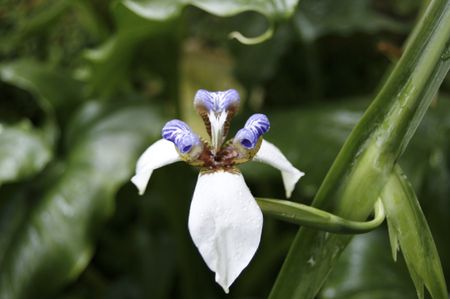Neomarica Iris: How To Care For Walking Iris
Plant some walking iris in the garden where you want lush greenery and pretty blooms. Unique in their looks and propagation habits, these are fascinating additions indoors or out


Ultimate Guide To Growing Walking Iris
With their attractive, glossy foliage, walking iris plants, also known as “fan iris” or “apostle plants,” are an excellent addition to borders, mixed beds, and containers. Their adaptability and appeal also make them great for growing indoors as houseplants. A closer look at these unique flowers can help us better understand when to plant and how to care for walking iris. In this article, we will explore its specific needs in greater detail.
Quick Walking Iris Facts
- Botanical name:
- Neomarica gracilis
- Height: 24-36 inches (61-91 cm.)
- Spread: 12-18 inches (30-45 cm.)
- Sun exposure: Full sun, part shade
- Soil requirements: Neutral, slightly acidic
- Hardiness zones: USDA zones 8-11
- When to plant: Spring, fall
Caring for Walking Iris
Walking iris is an unusual plant. Its stalks bend to the ground and release their plantlets, which root in the soil to make dozens of new plants. The new plants can repeat this process across the garden, thus the name “walking.” Certain species don’t bend, however, and simply hold the plantlet aloft on the stalk. There is a theory that the plant won’t bloom until it has at least 12 leaves, which explains the “apostle” label. This plant will grow in voluminous clusters in warm climates, but it does have specific requirements.
Lighting Conditions
Neomarica iris are adapted to a wide range of lighting conditions. Plants are best positioned where they receive ample sun throughout the day. The species also grows well in partially shaded beds, more specifically, those that are sheltered throughout the hottest parts of the afternoon.
Temperature & Humidity
Walking iris plants perform best in warm climates, behaving as an evergreen in USDA zones 10-11. Those outside of this range are likely to see the plant die back in winter, behaving more like an herbaceous perennial. Though tolerant of both heat and humidity, temperatures between 60-70 F (15-21 C) are ideal during periods of active growth.
Watering Needs
Gardening tips, videos, info and more delivered right to your inbox!
Sign up for the Gardening Know How newsletter today and receive a free download of our DIY eBook "Bring Your Garden Indoors: 13 DIY Projects For Fall And Winter".
Consistent moisture is key to this plant’s health. When plantinf walking iris in drier regions you may find that plants benefit from routine irrigation. Continued watering may also be needed during periods of prolonged drought or in gardens with especially warm summer weather. It’s a good idea to check moisture levels on a weekly basis, or with even greater frequency when the plants are being grown in pots or containers.
Fertilizing
Fertilization of walking iris plants should begin in spring, using a well-balanced feed. Throughout the season, routine feeding can continue at weekly or biweekly intervals. At this time, liquid drenches or foliar feeds are often considered most effective. Though fertilizers can help to promote vigor, some gardeners caution against their overuse and potential negative impact on plants.
Soil & Compost
Walking iris will flourish across a wide range of soils, preferring those that are neutral or slightly acidic. Adding finished compost and other amendments at planting time can further aid in the preparation of garden soil. Though these plants benefit from consistent moisture, their beds should drain well, allowing excess water to flow freely.
Problems, Pests & Diseases
In the garden, walking iris only seldom has problems with disease. When being grown indoors they are likely to be affected by several common pests, including aphids, mealybugs, and spider mites. Sudden changes in plant health related to nutrient levels in the soil may also occur. This will usually manifest in chlorosis, making yellow walking iris foliage a cause for concern.
When and How to Plant Walking Iris
Walking iris plants are most commonly purchased as small starts. Availability and timing will vary from zone to zone, with most plants arriving in either fall or spring. If you are living within the plant’s hardiness range you can plant them outdoors immediately or keep potted specimens as houseplants.
Walking iris care indoors closely mimics care for those in the garden, paying close attention to the specific needs of the species. Though it may be possible to plant walking iris from seed, doing so is likely to yield inconsistent results. Plants from seed may not grow true-to-type, with some cultivars producing seeds that are not viable or flowers that are sterile.
Walking Iris Deadheading & Pruning
Like other types of iris, Neomarica plants will benefit from routine deadheading. Faded flowers can be removed from the plant at any point in the season to preventing them from producing seed.
These plants only seldom require pruning. In regions where the plants die back to the ground, removing dead or decaying debris is essential to prevent the spread of disease and to keep beds tidy through winter. Those behaving as evergreens may also need minor pruning in spring, to trim away any leaves that have died back or been damaged by cold.
Walking Iris Propagation
True to their namesake, this species can be propagated with ease. Under ideal conditions, each flower stalk will produce a “plantlet” at the top of the stalk. These specialized structures bend towards the ground and allow the plantlet to take root upon contact with the soil. The process then repeats, generating the formation of large clumps.
Large groups of these iris plants can be divided or potted into individual containers. This is generally done in spring, just as the plants begin to flower. Though walking iris are known to spread, they are not considered invasive.
Frequently Asked Questions
Where is the Best Place to Plant Walking Iris?
Walking iris plants are a good candidate for low-maintenance gardens. As they are relatively carefree, established plantings can thrive with little attention from growers. Plants can also be kept in containers to adorn porches, patios, and indoor spaces.
Does Walking Iris Spread?
Many growers are attracted to walking iris for its unique spreading habit. Though the plant is known to multiply, new growth is slow and can be controlled easily.

Nikki Tilley has been gardening for nearly three decades. The former Senior Editor and Archivist of Gardening Know How, Nikki has also authored six gardening books.
-
 Growing For Gold: 9 Unique Yellow Flowers To Grow For Sunshine Garden Color
Growing For Gold: 9 Unique Yellow Flowers To Grow For Sunshine Garden ColorFrom vivid sunny lemons to rich butterscotch tones, yellow is a color that deserves a spot in every garden. These nine unique yellow flowers will fill your plot with cheer
By Tonya Barnett
-
 Pacific Northwest Gardeners: Here’s Everything To Plant In March For A Thriving Garden
Pacific Northwest Gardeners: Here’s Everything To Plant In March For A Thriving GardenLearn what vegetables, flowers, shrubs, and fruits you should plant in March for best results in Oregon, Washington, Northern California, and British Columbia.
By Bonnie L. Grant
